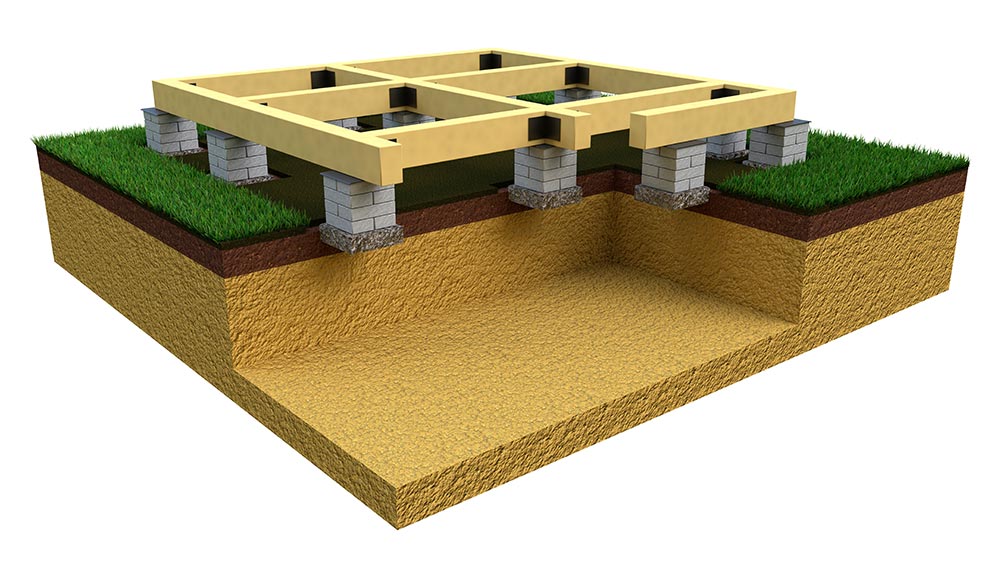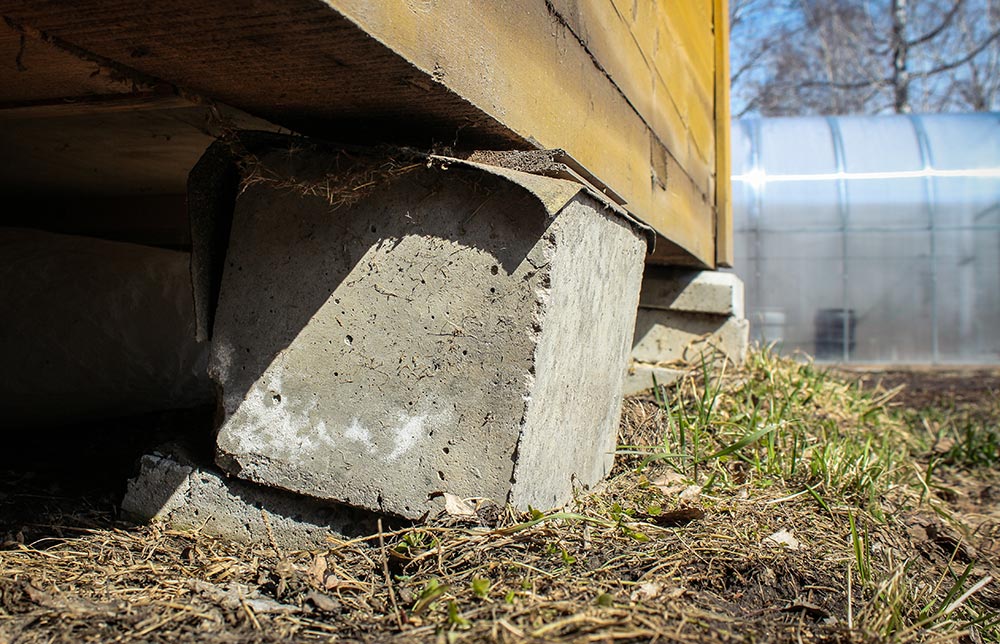A lot of homes were built before 1960 when pier and beam foundations were more common. These foundations have crawlspaces underneath, which can have a number of benefits. But many of them start to fail as they get older. Pier and beam foundation repair works a little differently than concrete slabs, and the same is true for their restoration.
Pier and beam foundations are made up of a lot of vertical concrete bases that support the structure, which are referred to as “piers.” This design approach lifts the support members of a structure’s floor, which are referred to as “beams.” The piers keep the beams away from the damp ground, which reduces the likelihood of damage when there’s a flood. It also creates a more convenient space for HVAC units, plumbing, and electrical wiring.

Parts of a Pier and Beam Foundation
Sometimes referred to as a “post and beam foundation” or a “crawlspace foundation,” this type of design is built above ground level. It will have the following components:
- Piers — These vertical columns are usually made of concrete or brick and are dug deep into the ground to support the weight of the house. They provide stability by anchoring into more stable layers of the ground, which can resist shifting or settling.
- Beams — These are the horizontal structures that sit on top of the piers and will span the length or width of the home. The beams are meant to carry the load of the house by distributing it evenly across the piers.
- Crawlspace — This is the space that’s left between the ground and the home’s base, which not only makes it easier to access plumbing and electrical systems but also provides a barrier from ground moisture.
This type of design can also reduce the risk of certain types of damage or decay.
The Advantages of a Pier and Beam Foundation
Some of the advantages of pier and beam design include the following:
- Flexibility — They’re a great option for shifting soils, because they can be adjusted more easily than slab foundations.
- Accessibility — The crawlspace makes it easier to access, repair, or modify utilities without digging.
- Moisture Prevention — The elevated design can give you more protection from flooding. It can also reduce the risk of mold and rot.
Like any other foundation, pier and beam systems have their challenges. It’s important to inspect it on a regular basis, because it will make sure the wood is free from rot and pests. It will also make sure the piers are stable and aligned.

Approaches for Pier and Beam Foundation Repair
Every project starts with a thorough inspection so that any challenges to the foundation can be identified. From there, a customized repair strategy can be created to make sure the home’s stability is maintained. Depending on the type and extent of the damage, pier and beam foundations can be repaired in a number of ways. Some of the solutions that can be used include the following:
- Support Jacks — This involves the use of crawlspace support jacks that will provide support for your pier and beam foundation. By crawling under your home and measuring its distance from the ground, a base can be laid down for each support jack. Once they’re set, they can offer enduring support that will make sure your foundation remains stable.
- Sonotubes — These act as hollow concrete columns and are strategically placed around the foundation. The damaged pier and beam footing is removed and is replaced with a robust concrete form. This technique will not only restore the foundation but will also boost its ability to provide support for your home.
- Shoring — If your pier and beam foundation is showing signs of wear, shoring can serve as an immediate remedy. By affixing newer and more resilient beams, joists, and piers to the damaged ones, it can create an extra layer of support that will maintain your home’s structural integrity.
The process of pier and beam foundation repair can’t be done in a single step. It’s a process that starts with preparing the site. Shrubs and plants have to be moved out of the way, so the repair crews can have access to the area. The foundation has to be stabilized by raising the floor levels to their natural position. Old parts have to be replaced with new ones, so the home has enough support. Extra beams can also be added to areas that need more reinforcement.
Pier & Beam Foundation Repair FAQ
A pier and beam foundation can give your home a great deal of structural integrity while also providing a spacious crawlspace, but it will need maintenance and repair as the years and seasons go by. Your home’s foundation plays a critical role in keeping it stable and structurally sound. So, any issues can lead to serious problems (such as structural damage and other safety hazards). Not to mention, the reduction in property value.
Here are some common questions people ask about pier and beam foundation repair.
include the following:
– Sunken floors and foundations.
– Uneven floors and noticeable slopes in your home.
– A patio that’s pulling away from your home.
– Cracks in the walls and ceilings.
– Gaps in the caulking around your doors and windows.
– Doors and windows that are getting stuck or are hard to open and close.
– Gaps that are growing between the crown molding and your ceiling.
– Wallpaper that’s creasing or wrinkling.
– Bowed walls.
If you notice any of these signs, you should reach out to a professional as soon as possible.
Whether you’re buying a new home or need to repair an existing one, it’s important to inspect your foundation. It’s also helpful to know if your pier and beam structure is working properly, are compliant with building codes, and whether they need any modification or repair. It will also involve an interior and exterior examination (which includes looking at cracks, support beams, and load-bearing devices).
Inspecting a pier and beam foundation will also require the following:
– Checking the operation of doors and windows.
– Evaluating the integrity of walls and floors.
– Checking for water damage, mold, and ventilation.
– It’s also important to check the following:
– Water drainage.
– Crumbling concrete.
– Buckling walls.
– Bulges and slopes in your foundation and floors.
The piers, beams, and joists will need to be inspected. Any wooden parts must also be inspected for signs of moisture or rotting.
A pier and beam foundation repair may involve the following:
– Adjusting or replacing the piers.
– Shimming the beams.
– Fixing or replacing any damaged joists.
Any soil issues will also have to be addressed, so the foundation’s stability can be secured.
The cost of a pier and beam foundation repair will usually be from $1,000-$4,000, depending on the quality of the materials, the stability of the soil, and whether it was regularly maintained. Extensive wood rot or foundations in poor condition can cost significantly more.
Many contractors will adjust piers to correct any settling issues or to realign the structure. This is especially true if the service performed by a previous contractor didn’t adequately address any initial issues related to sinking or soil instability.
If they’re installed correctly and are in stable soil conditions, concrete piers can last a very long time. But, soil movement and other environmental factors can affect their lifespan.
The exact cost of the replacement will depend on the beam’s length, the type of wood being used, and the complexity of the installation. But you can expect it to cost between $1,500 and $4,000. Be sure to speak with a local foundation repair specialist for a more accurate estimate.
You can take some simple steps to keep your foundation in good shape, which can include the following:
Regrading your yard — Slope the ground away from your house, so rainwater can flow downhill instead of pooling around your foundation.
Installing downspout extensions — This will allow you to direct water away from your foundation (which will reduce the risk of hydrostatic pressure, moisture damage, and foundation cracks).
Cleaning gutters on a regular basis — This will keep water from overflowing and running down the side of your house, which will soak the ground around your foundation.
Installing a drain tile system — This is a network of buried drainage pipes that are installed around your foundation at the footing level and will keep excess groundwater away from the area.
Keeping trees away from your foundation — Tree roots can grow deep and wide. And if they start to invade the ground under your foundation, they can cause all kinds of damage. So if you want to plant trees on your property, you should keep them at least 50 feet away from your home.
If you’re looking for one of the best places for foundation repair in Corpus Christi, be sure to reach out to Streem Foundation Repair.
